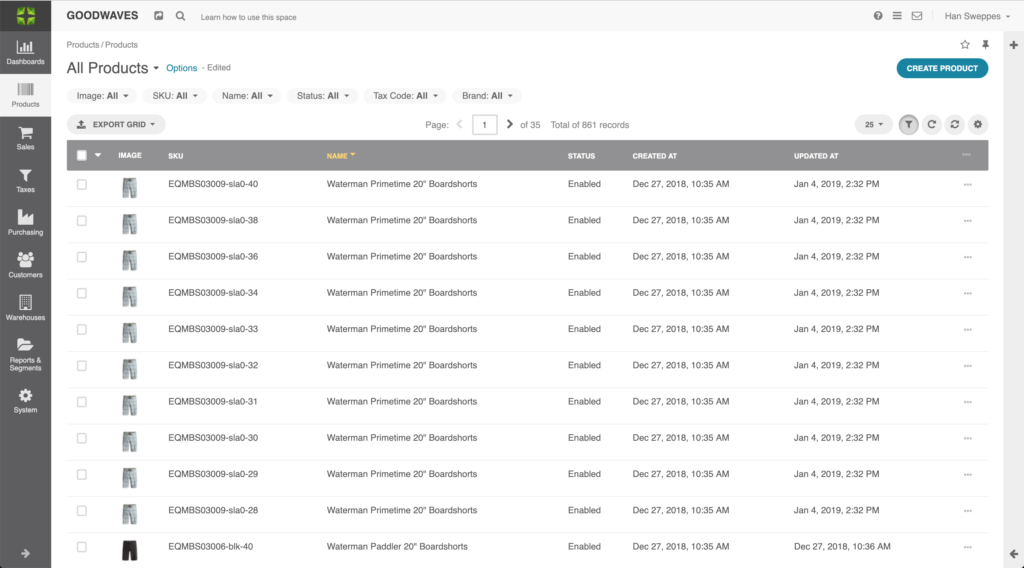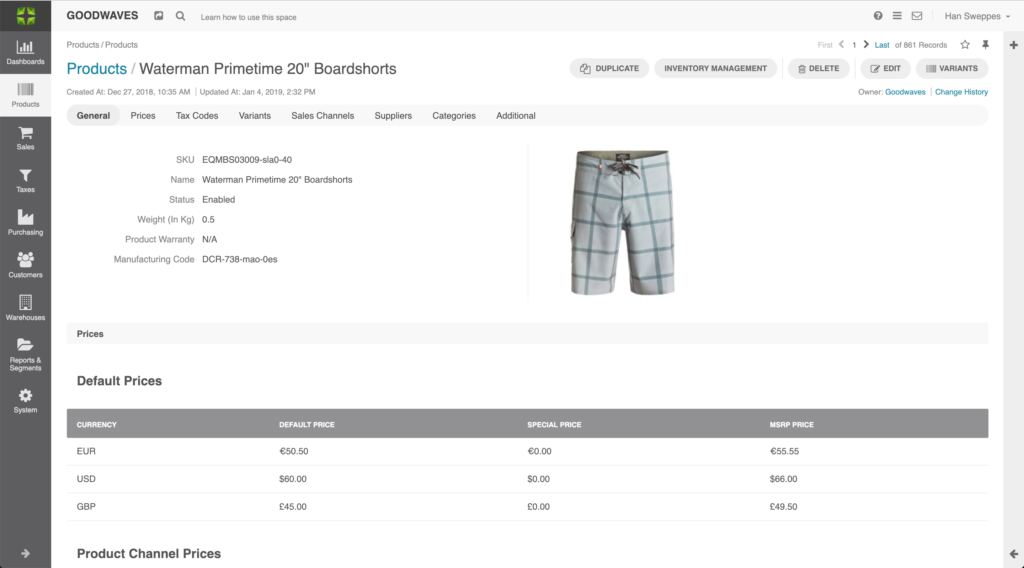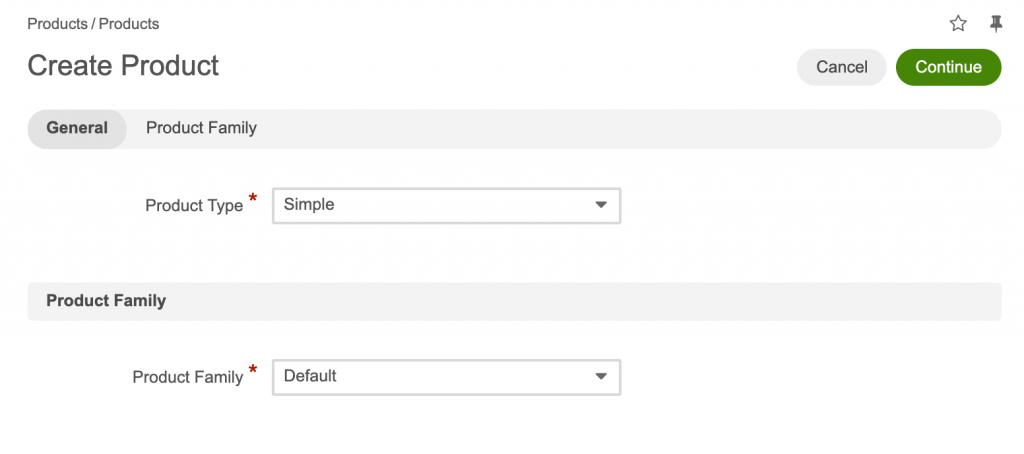Definition of a Product
A Product is an item or service that can be sold in sales channels. A product has multiple attributes like SKU, Price, Name, and Color to specify the specific product. These products get assigned to sales channels, warehouses, and inventory levels, giving a comprehensive overview of what’s available for sale and how many items are available in the inventory.
Data grid Products
Get an overview of all products in the system.
- Click on Products in the menu and then go to → Products

- Image: A thumbnail representation of the product
- SKU: Stock Keeping Unit: Unique product code
- Name: Name of the product
- Status: Shows whether the product is enabled or disabled in sales channels
- Product type: what type of product it is (simple or subscription)
- Created at: Shows when the product was created
- Updated at: Shows when the product was updated
Product Mass actions
Two mass actions are available on the product overview page. These offer the possibility to remove multiple products at the same time or to link several products to sales channels simultaneously.
- Select the products you want the action to apply to, by selecting the checkbox before the product. You can also use the filters to narrow the number of products and use the drop-down in the grid header to Select “All” or “All Visible” products.
- In the grid header at the right side, use the dropdown with the three dots to select the mass action type you want to apply on the selected products.
- Choose “Delete” if you want to delete the selected products. You will see a warning as a double-check for whether you really want to delete the selected products.
- Choose “Assign Sales Channels” if you want to link the selected products to Sales Channels. A page will be shown with an overview of the Sales Channels. Select the Sales Channels you want to link to the products and click the “Save” button.
Product overview
An overview of an individual product.
- Navigate to Products → Products → Click on a product. By clicking a product in the product overview, a product ‘view’ page will open.

On this page you find the following information:
General
- Name: Name of the product
- SKU: Stock Keeping Unit, Unique product code
- Status: Whether a product is active in the system
- Weight: The weight of a product, used for shipping purposes
- Product Warranty: The amount of days a product has a warranty
- Manufacturing Code: Manufacturer identification code
- Image: Reference to an image
Prices: Default Prices
- Currency: Currencies related to the product assigned Sales Channels
- Default Price: Default price per currency
- Special Price: Special Price per currency
- MSRP Price: Manufacturing Suggested Retail Price per currency
Prices: Product Channel Prices
- Sales Channel: Sales channel with divergent price
- Currency: Currencies related to the product assigned Sales Channels
- Price: Price in the corresponding Sales Channel currency
- Special Channel Price: Special Channel Price in the corresponding Sales Channel currency
Tax Codes: Default Tax Code
- Tax Code: Default Tax Code
Tax Codes: Sales Channel Tax Codes
- Sales Channel: Sales channel with divergent Tax Code
- Tax Code: Tax Code
Variants
- SKU: Stock Keeping Unit: Unique product variant code
- Name: Name of the product variant
- Inventory qty: Total available inventory of the product variant
- Status: Status of the product variant
- Manufacturing code: Manufacturer identification code
- Weight: The weight of a product, used for shipping purposes
- Product warranty: the warranty of the product
Sales Channels
- Name: Name of the Sales Channel in which the product is sold
- Code: Code of the Sales Channel in which the product is sold
- Type: Sales Channel type (like; POS, Webshop, Amazon)
- Currency: Currency in which the Sales Channel is selling the product
- Active: If the Sales Channel is currently active or not
- Default: If the Sales Channel is a default Sales Channel
Suppliers
- Name: Name of the supplier
- Quantity of Unit: The obligatory quantity of unit that has to be purchased at the supplier
- Priority: Priority of the supplier when multiple suppliers can supply you with new products
- Cost: Cost of the product if purchased in quantity of unit
- Can Dropship: Whether the supplier can drop ship or not
Categories
- Code: Code of the category
- Name: Name of the category
- Created at: Creation date of the category
- Updated at: Update date of the category
Additional
- Additional custom product attributes: Extra information about the product, such as the color
Create a product
- Navigate to Products → Products
- Click on the ”Create Product” button in the top right of the screen.

3. Fill in the product type (Simple or Subscription)
4. Choose the product family the product belongs to
5. Click the “Continue Button”
6. Fill in the following details:
General
- Name: Name of the product
- SKU: Stock Keeping Unit: Unique product code
- Status: Whether a product is active in the system
- Weight: The weight of a product, used for shipping purposes
- Product Warranty: The number of days a product has warranty
- Manufacturing Code: Manufacturer identification code
- Image: Reference to an image
Prices
Default Price
A default price is the price of the product in a specified currency. The available currencies are related to the assigned Sales Channels and their currency setting.
- Currency: Currencies related to the product assigned Sales Channels
- Price: Default price per currency
Special Price
A special price is the discounted price of the product in a specified currency. Available currencies are related to the assigned Sales Channels and their currency setting.
- Currency: Currencies related to the product assigned Sales Channels
- Special Price: Special price per currency
MSRP Price (Manufacturer Suggested Retail Price)
An MSRP Price is the by the manufacturer suggested retail price of the product in a specified currency. The available currencies are related to the assigned Sales Channels and their currency setting.
- Currency: Currencies related to the product assigned Sales Channels
- MSRP Price: MSRP per currency
Product Channel Price
Prices may differ between various sales channels even if they use the same currency. If you want to overwrite the default price for a specific sales channel check the checkbox and define pricing for specific channels.
- Check the checkbox to enable channel pricing
- Click to add pricing for a channel
- Select a Sales Channel for which you want to specify a different price
- The Sales Channel currency will automatically be shown
- Add the price
- Sales Channel: Sales channel with divergent price
- Currency: Currencies related to the product assigned Sales Channels
- Default Channel Price: Default Channel Price in the corresponding Sales Channel currency
- Special Channel Price: Special Channel Price in the corresponding Sales Channel currency
Tax Codes
Default Tax Code
Set a default Tax Code for the product. When there are no Sales Channel Tax Codes defined, this is the Tax Code products will fall back upon.
- Tax Code: Default Tax Code
Sales Channel Tax Codes
Tax Codes may differ between various sales channels. If you want to overwrite the default Tax Code as described in “Default Tax Code” check the checkbox and define pricing for specific channels.
- Click “Add Sales Channel Tax Code”
- Select a Sales channel
- Select the Tax Code
- Sales Channel: Sales channel with a divergent Tax code
- Tax code: Tax code related to the Sales Channels
Sales Channels
Linking Sales Channels to a product determines in which Sales Channels a product is offered for sale. When creating a product all Sales Channels that are set as “default” will be automatically assigned to the product.
- Use the filters to search for the correct Sales Channels
- Select the appropriate Sales Channels by checking the checkbox. Selected Sales Channels will be marked yellow.
- Name: Name of the Sales Channel in which the product is sold
- Code: Code of the Sales Channel in which the product is sold
- Type: Sales Channel type (like; POS, Webshop, Amazon)
- Currency: Currency in which the Sales Channel is selling the product
- Active: If the Sales Channel is currently active or not
- Default: If the Sales Channel is a default Sales Channel
Suppliers
To purchase new inventory for a product the product needs to be linked to one or more suppliers.
- Click “Add Supplier”
- Select a Supplier
- Set the quantity of unit
- Set the priority
- Enter the cost of the product for this quantity of unit
- Set if the Supplier can handle drop shipments
- Name: Name of the supplier
- Quantity of Unit: The obligatory quantity of unit that has to be purchased at the supplier
- Priority: Priority of the supplier when multiple suppliers can supply you with new products
- Cost: Cost of the product if purchased in quantity of unit
- Can Dropship: Specify whether the supplier can drop ship or not
Categories
Categorize your products by assigning one or more categories to a product. Categorizing products can be helpful to create subsets within your products. These subsets can be used in different ways, for example in reports or building menu structures in Sales Channels such as webshops and marketplaces.
- Use the filters to search for the correct Categories
- Select the appropriate Categories by checking the checkbox. Selected Categories will be marked yellow.
- Code: Code of the category
- Name: Name of the category
- Created at: Creation date of the category
- Updated at: Update date of the category
Additional (if applicable)
If there are additional custom product attributes created they will be shown in this chapter “Additional”.
Subscription
In case of a subscription product, rules for the subscription may be set.
- Subscription duration: total length of the subscription agreement
- Number of deliveries: times the product is delivered during the total length of the subscription agreement
- Payment term: at what time(s) the subscription is paid for
- Special price Duration: whether the subscription continuous after the subscription duration, or whether it stops
Duplicate a Product
From the Product List
- In the main menu, navigate to Products → Products. The product list opens.
- Choose the product that you need to duplicate, click the More Options menu at the end of the row, and then click the Duplicate icon.
The duplicated product opens. It has a Disabled status and its SKU is automatically generated by adding a hyphen and a duplicate version number to the original SKU. Now you can edit the duplicated product to customize its settings as required.
From the Product View Page
- In the main menu, navigate to Products → Products. The product list opens.
- Click the product that you want to duplicate.
- Alternatively, click the More Options menu at the end of the row and then click the View icon.
- The product view page opens.
- Click Duplicate on the top right.
The duplicated product opens. It has a Disabled status and its SKU is automatically generated by adding a hyphen and a duplicate version number to the original SKU. Now you can edit the duplicated product to customize its settings as required.
